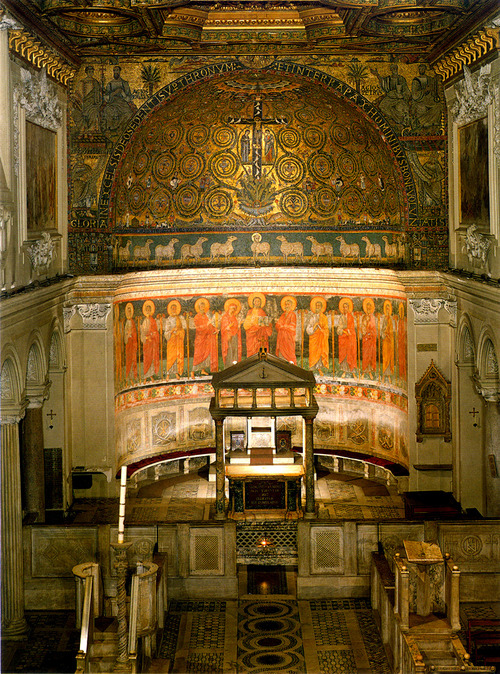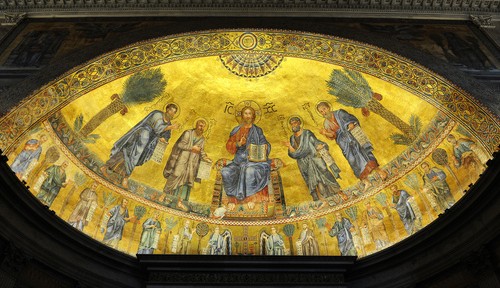St. Germanus of Constantinople writes:
The apse corresponds to the cave in Bethlehem where Christ was born*, as well as the cave in which he was buried, as the evangelist Mark says: “There was a cave hewn out of the rock; there they placed Jesus” (cf Mark 15:46)
Knowing now as we do that the church building as a whole is a restatement of the Garden of Eden, these two caves have particular significance. Regarding the burial cave, the evangelist John places it in the context of a garden:
Now there was in the place where he was crucified, a garden; and in the garden a new sepulchre, wherein no man yet had been laid. (John 19:41)
As for the nativity cave, Luke also places it, if not in a garden, at least in a pastoral setting:
And she brought forth her firstborn son, and wrapped him up in swaddling clothes, and laid him in a manger; for there was no room for them in the inn. And there were in the same country shepherds watching, and keeping the night watches over their flock. (Luke 1:7-8)
The scene is reminiscent of that depicted in the apse of Sant’Apollinare in Classe, above, in which Saint Apollinaris, the Alter Christus, tends to his flock in a verdant world unblemished by sin and death. In the apse at San Clemente below, the Tree of Knowledge of Good and Evil has transmogrified into the Tree of Life which sprouts from the base of the Cross. It also depicts the four rivers of Eden (Genesis 2:10).
The dome is the classic symbol of Heaven as its shape imitates the dome of the sky. It is fitting as the Sanctuary is a little piece of Heaven. It is in the world, but not of the world, and so is demarcated, just as was the debir, the Holy of Holies of the Temple at Jerusalem. Says Saint Germanus:
The chancel barriers indicate the place of prayer: the outside is for the people, and the inside, the Holy of Holies, is accessible only to the priests. The barriers, made of bronze, are like those around the Holy Sepulchre, so that no one might enter there by accident.
St. Germanus wrote this before the development of the iconostasis, so I assume he was writing about a templon, a high knee wall which looks like an over-sized altar rail. San Clemente’s templon is typical. At Sant Apollinare, I can only guess that a templon was removed in the 9th century when the apse floor was raised to make way for a new tomb.
The apse also has a model in the ancient Roman basilica. In the apse sat the magistrates, deliberating, meting out justice, and offering pagan sacrifice on an altar. Likewise, Christ sits in judgment on the altar, His throne, and offers the perfect sacrifice. The depiction of Christ Pantocrator in the apse dome, as at San Paolo Fuori le Mura below, is fairly common in early church buildings.
The pagan magistrate’s throne remains at the apex of the apse; however, now it is occupied by the Bishop with his attendants, deacons, sub-deacons, archpriests, to either side. While this traditional arrangement died out in the West, in the East every parish church today has a Bishop’s throne in the apse.
+ + +
* In the Eastern tradition, Christ was born not in a wooden stable, but in a cave.








Thanks these places are beyond belief.
I find the comparison between the basilican apse and Christ’s burial cave intriguing. It appears that the early Christians were aware of this symbolism early on through the use of this motif during the construction of the catacombs. The arcosolia were used for the wealthy and for martyrs according to the Catholic Encyclopedia. It continues ” An arcosolium was a space excavated in the wall above which a semicircular recess was hewn out, in which a sarcophagus was sometimes placed; in the excavation below, the body was laid and covered with a flat marble slab.” The Christian catacombs were modeled on the earlier Jewish catacombs in Rome which imitated the rock-graves used in Palestine but the actual carving of this arch-like space above a tomb was particular to Christians only. These arcosolia also had inscriptions and paintings of various Christian themes from episodes of the Old and New Testament, to Marian theology and representations of the Eucharist. So it would seem that the Apse and Altar are inseparable as a motif, especially as it pertains to the celebration of the Eucharist by the early Christians. The same setup appears to have been carried from the catacombs to the Churches after the persecutions cease.